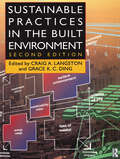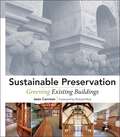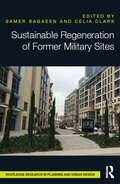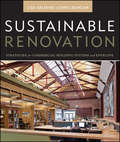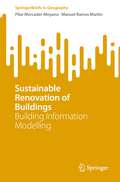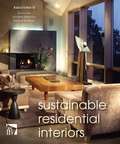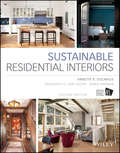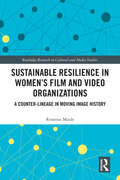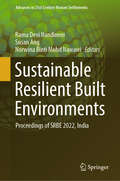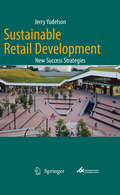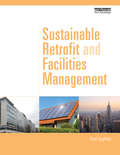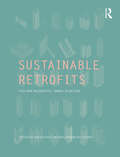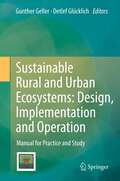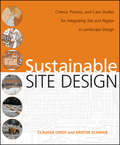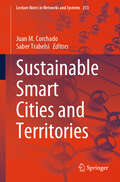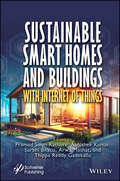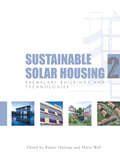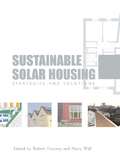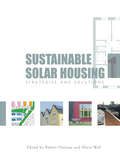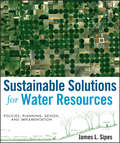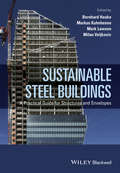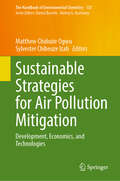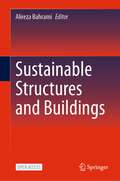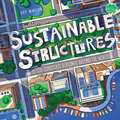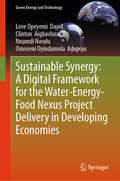- Table View
- List View
Sustainable Practices in the Built Environment
by Craig A. Langston Grace K.C. DingSustainability is a key issue and its impact on the construction industry, as one of the major users of the Earth's resources, is starting to take hold. This book deals with sustainability as it affects the construction industry, looking at the techniques and issues which designers, engineers, planners and construction managers will have to deal with in their day-to-day activities. It covers methods of analysis such as environmental impact assessment and cost-benefit analysis as well as topics on design and energy regulation and conservation. The book is an important introduction to the subject for senior undergraduate and postgraduate students. Given the importance and novelty of the subject, professionals in the construction industry will also find the book valuable.
Sustainable Preservation
by Richard Moe Jean CarroonA guide to green strategies for preservation and adaptive reuse--and the power of preservation/reuse as a green strategy.Buildings account for nearly forty percent of both total energy use and carbon emissions in the United States. With one of the country's leading preservation architects as your guide, Sustainable Preservation explores the power of adaptive reuse to reduce those numbers and move us toward sustainability. It shows how an icon such as H.H. Richardson's Trinity Church in Boston can go green--and why a 1970s strip-mall supermarket not only deserves similar attention but can also emerge as a building that delights users.Sustainable Preservation takes a nuanced look at the hundreds of choices that adaptive reuse requires architects to make--from ingenious ways to redeploy existing structural elements to time-honored techniques for natural ventilation to creation of wetlands that restore a site's natural biological functions. In addition, Sustainable Preservation:Presents fifty case studies of projects--schools, houses, offices, stores, museums, and government buildings--that set new standards for holistic approaches to adaptive reuse and sustainabilityCovers design issues, from building location to lighting systems, renewable power options, stormwater handling, and building envelope protection and integrity.Reviews operational issues, including materials choices for low lifetime maintenance, green housekeeping, and indoor air qualityExplains calculators and programs that supplement the LEED® green building certification program requirements to yield even greater environmental benefitsSustainable Preservation makes a compelling argument that preservation and sustainability don't just protect the environment, but deliver a full range of societal benefits, from job creation to stronger social connection.On the Cover: Trinity Church in Boston: Under the leadership of Jean Carroon, Goody Clancy recently completed restoration and expansion of H.H. Richardson's 1877 masterpiece, Trinity Church. Significant environmental aspects include a new below-grade assembly space that incorporates the structure's massive stone piers; installation of ground-source heat pumps that dramatically reduce heating and cooling requirements; complete on-site management of all stormwater; and full use of local, recycled, and low-VOC materials.
Sustainable Regeneration of Former Military Sites
by Samer Bagaeen Celia ClarkSustainable Regeneration of Former Military Sites is the first book to analyze a profound land use change happening all over the world: the search for sustainable futures for property formerly dedicated to national defense now becoming redundant, disposed of and redeveloped. The new military necessity for rapid flexible response requires quite different physical resources from the massive fixed positions of the Cold War, with huge tracts of land and buildings looking for new uses. The transition from military to civilian life for these complex, contaminated, isolated, heritage laden and often contested sites in locations ranging from urban to remote is far from easy. There is very little systematic analysis of what follows base closures, leaving communities, governments, developers, and planners experimenting with untested land use configurations, partnership structures, and financing strategies. With twelve case studies drawn from different countries, many written by those involved, Sustainable Regeneration of Former Military Sites enables the diverse stakeholders in these projects to discover unique opportunities for reuse and learn from others’ experiences of successful regeneration.
Sustainable Renovation
by Chris Duncan Lisa GelfandThe complete resource on performing sustainable renovations for both Historic and modern existing buildingsThis forward-looking and insightful guide explores how the sustainable renovation of existing buildings presents great opportunities for initiating extensive changes in the performance of the built environment. Great examples of existing building upgrades are examined, illustrating how to do sustainable renovations, along with current design approaches for radically improving the functionality of existing prewar, postwar, and late modern buildings. Sustainable Renovation saves its key focus for institutional and commercial buildings, but discusses the challenges they pose within a global scope that encompasses all building practices. Some of the discussions in this book include:The significance of energy and resource demands by the building sector and the urgency of reducing loads in existing buildingsManagement, design, and construction approaches to achieve major modernization in occupied buildingsInternational case studies that focus on methods and benefits of successful sustainable transformations of existing building performanceRepurposing buildings to preserve style and add performance remains a work in progress as designers and builders discover new methods for improving sustainable practices and standards. With incremental modernization and operations strategies available for immediate implementation, this book demonstrates the different ways of thinking necessary when considering and attempting the integration of sustainable concepts into existing buildings--and enables readers to rethink the world that's built around them.
Sustainable Renovation of Buildings: Building Information Modelling (SpringerBriefs in Geography)
by Pilar Mercader-Moyano Manuel Ramos MartínThe book provides a complete vision about Spanish sustainable renovation of buildings situation at this moment, analysing legal and technological context and opportunities that economic stimulus —by means of direct aids— and the use of BIM methodologies offers a standardization of high scale interventions.Nowadays, BIM models let us integrate multiple quantitative parameters that can agile the information to interchange between stakeholders. Using this potential to standardize protocols of interventions and share knowledge is necessary to face a high scale intervention that our cities need.Climatic Emergency and socioeconomic crisis caused by recent events —COVID-19 and hydrocarbons crisis— are the two principal struggles we face as society. European Politics, embodied by National Energy and Climate Plans (NECPs) developed by each region give the way to the green transition of different productive sectors.Our building stock is responsible for approximately 36% of the CO2 emissions in the European Union. For this reason, these policies focus a large part of their efforts on economically incentivizing a new development model for the building sector that is committed to the large-scale renovation of the existing real estate stock and that, through the reduction of energy demand and of emissions, manage to reduce the environmental impact of these. Next Generation EU is the new recovery instrument that aims to mobilize investments towards strategic sectors for the reorientation of the production model that, among other measures, contributes to decarbonization through the promotion of energy efficiency and the deployment of renewable energies.
Sustainable Residential Interiors
by Foster Annette Stelmack Debbie HindmanAn illustrated guide to "green" design strategies"This is a book that many in the design community have been waiting for--a volume that clearly and succinctly lays out the strategies and tools at our disposal for creating interiors that will serve not only our clients' needs, but also those of the planet. Best of all, it's an inspiration to read, allowing each of us to see our way to becoming a part of the design solution needed for a sustainable future. If you are a designer, you need this book!"--Sarah Susanka, FAIA, author of the Not So Big series and Home by Design"This excellent book will benefit designers of residential interiors that incorporate sustainable design into their practices or are looking to begin to do so. Designers may be surprised by the variety of projects shown that are great examples of residential sustainable interiors."--Bernadette Upton, ASID, LEED AP, founding member of the Sustainable Design Council and member of the Florida Green Building CoalitionIssues of sustainability and environmental consciousness have been increasingly important to designers of residential interiors. A leading firm that has built its expertise in addressing environmental concerns in residential interiors, Associates III presents solutions for the design practitioner in this book. Covering topics such as indoor air quality, identifying low-impact materials, conserving energy and water, and support of construction teams in reducing waste, Sustainable Residential Interiors provides designers with the necessary information and tools to integrate environmentally responsible design into their practice.Sustainable Residential Interiors takes readers through an integrated design process, showing how sustainable principles and practices can be applied on virtually every level of interior design. Taking a practical, hands-on approach, this accessible and easy-to-understand resource guide includes:Visual examples of sustainable projects and applicationsCritical thinking about environmental issues within homesGuidelines for clients and project teamsHelpful checklists for greening projects and specificationIn-depth information to promote understanding and assist in specifying interior finishes and furnishingsQuestions for manufacturers and vendorsEffective methods of marketing sustainable design services
Sustainable Residential Interiors
by Annette Stelmack Debbie Hindman Associates III Kari FosterThe Second Edition of Sustainable Residential Interiors addresses cutting edge processes, strategies, and principles as well as details for in-depth product vetting criteria. Award-winning, leading interior designer Annette Stelmack shares her expertise from the perspective of LEED Building Design & Construction projects, healthy interiors, and chemical sensitivities, addressing principles, strategies, and solutions for design practitioners. A comprehensive update of the current state of the sustainable interior design industry is provided, including present and upcoming industry transformations, thought-leading principles, strategies and practices for project implementation, and fine points and resources for in-depth product vetting to support high-performing, healthy interiors. Sustainable Residential Interiors takes readers through an integrated design process, demonstrating relevant principles and practices that apply to essentially any interiors project toward creating an environment that is healthy, high-performing, functional, sustainable, and beautiful. In doing so, it: Promotes critical thinking about health and environmental issues in the building industry Features checklists and current resources, providing a "hands on" practical approach Addresses in-depth, applicable third party certifications and details on relevant building rating systems Provides in-depth strategies and criteria for fixed interior finishes, fixtures, equipment and furnishings Demonstrates successful, relevant, diverse and inspiring case studies Delivers comprehensive tools and resources for researching and vetting products' composition and chemical make-up. Evaluates all aspects of a building's interior to identify and implement methods that: save energy and water; reduce Co2 emissions and waste; improve indoor air quality free of toxins; and are responsive to environmental impacts Encourages forward-thinking by featuring inspirational statements from mentors, peers, and industry leaders Urges interior designers to commit to designing safe, healthy environments that are integral to a professional code of ethics, which ensure the delivery of positive outcomes for the client and any building's future occupants
Sustainable Resilience in Women's Film and Video Organizations: A Counter-Lineage in Moving Image History (Routledge Research in Cultural and Media Studies)
by Rosanna MauleThis book illustrates a distinctive lineage of critical interventions in moving image culture and in the public sphere through the trajectories of a small number of film and video organizations established between the 1970s and the early 1980s in Western Europe and North America mainly by women and still operative today. The six case studies examined (Drac Màgic, Women Make Movies, Groupe Intervention Vidéo, Leeds Animation Workshop, bildwechsel, Centre Audiovisuel Simone de Beauvoir) have maintained a discrete yet continuing presence within an audiovisual industry and a cultural system dominated by institutionalized, state-funded, and corporate forms of audiovisual production and distribution. Their longevity—quite a rarity in the independent circuit—makes a strong case for the sustainability of feminist/LGBTQ media activism in the public sphere, in spite of its low-key profile. This volume will be of interest to academicians of history and communication studies, feminist and LGBTQ topics and gender-related cinematic culture.
Sustainable Resilient Built Environments: Proceedings of SRBE 2022, India (Advances in 21st Century Human Settlements)
by Susan Ang Rama Devi Nandineni Norwina Binti Mohd NawawiThe proceedings of Sustainable Resilient Built Environments are based on the SRBE 2022 conference held in December 2022. It focuses on the advances under the overarching theme of ‘Sustainability’. The concept of ‘Sustainability’ has been conventionally defined as meeting the needs of the present without compromising the ability of future generations to meet their own needs. In scientific literature, sustainable development has been analysed using different qualitative approaches, such as economic, social, ecological, cultural, institutional, ethical, and political. In this edited volume, the concepts of both ‘sustainability’, and ‘resilience’ are considered to open up useful pathways towards achieving sustainable buildings and infrastructure. Though the concepts of sustainability and resilience are considered to help improve the built environment, the interrelations and interdependence between these two concepts are not clearly evident. This has led to the questions such as: Is thesustainable built environment always resilient? Is the resilient built environment always sustainable? What more is needed for sustainability? In exploring these pertinent questions, the proposed edited volume is expected to unveil and disseminate new insights on the themes related to sustainable and resilient built environment.The themes of the proceedings lay a platform for researchers and professionals to integrate the aspects including smart, innovation, technologies, green, energy efficiency, carbon reduction, sustainability and resilience with regard to buildings and other built infrastructure. Specific objectives included as per the five themes are as follows:Environment Design and SustainabilitySustainable & Smart BuildingsCommunity Resilience & Social SustainabilityHeritage and SustainabilityPandemic issues and sustainable development
Sustainable Retail Development: New Success Strategies
by Jerry YudelsonSustainable Retail Development, addresses the emerging issue of green retail buildings and retail development that will grow significantly in importance over the next half-decade, a trend seen throughout the developed world. This volume is a practical and comprehensive guide to greening retail real estate, including green building and marketing strategies, corporate sustainability programs and features a 10-point "action program" for greening any retail real estate portfolio. Sustainable Retail Development, should be essential reading for professionals in design, construction and operations of shopping centers and retail stores. Well illustrated, this volume features over 30 green retail developments from North America, Europe, South America, Asia and Australia, as well as interviews with 25 leading industry experts.
Sustainable Retrofit and Facilities Management
by Paul ApplebyGovernments across the globe are setting targets for reducing their carbon emissions. For example, the UK Government has committed to an eighty per cent reduction by 2050, when twenty-eight million buildings that currently exist will still be standing; this represents a challenge to improve the energy efficiency of more than one building per minute between now and 2050! This is a problem that needs tackling worldwide and is a challenge to both the refurbishment sector of the global construction industry and to those who own and operate existing buildings. Sustainable Retrofit and Facilities Management provides comprehensive guidance to those involved in the refurbishment and management of existing buildings on minimizing carbon emissions, water consumption and waste to landfill, along with enhancing the long term sustainability of a building. Practical guidance is provided on measures that can be used to improve the efficiency and sustainability of existing buildings, through both good management and refurbishment. Also explored is the relationship between the refurbishment of existing buildings, facility management and the wider community infrastructure. The book looks at management tools such as post occupancy evaluation, building health checks, energy management software, green building management toolkits and green leases. Illustrated throughout with case studies and examples of best practice, this is a must-have handbook for engineers, architects, developers, contractors and facility managers.
Sustainable Retrofits: Post War Residential Towers in Britain
by Asterios Agkathidis Rosa Urbano GutiérrezPresenting the state-of-the-art in sustainable retrofits in post war residential towers, this book captures and re-informs the current intense refurbishing process that is taking place in Britain, which is part of a global phenomenon happening all over the world, as cities upgrade their building stock in an attempt to comply with governmental emission reduction targets. The authors present inspections of 20 sustainably retrofitted social housing towers, analysing their aesthetic and technical modifications, as well as the shifts occurring in their social structure. The authors use over 200 full colour plans, elevations, photographs, maps and illustrations to beautifully support the statistical and analytical information collected. Finally they include interviews with some of the architects who designed the retrofits, residents and key stakeholders to inform the conclusions.
Sustainable Rural and Urban Ecosystems: Design, Implementation and Operation
by Detlef Glücklich Gunther GellerThese days human beings have a profound influence on aspects of the planetary ecosystem, e.g. on climate change and biodiversity, to name only two. This manual is intended to help practitioners, who are dealing with human-based rural and urban settlement-ecosystems, in the key steps towards their realization (design, implementation, and operation) and helpful for all, who are concerned about ensuring their practical sustainability. The ecosystem-approach is holistic and integrative, encompassing various disciplines like architecture, landscape architecture, environmental engineering, social sciences, life sciences, ecology, and management. It also considers issues such as energy-savings, ecological cycles, reuse, natural resources, socio-cultural background, real participation, and holistic quality management. Thus it not only explains the general concept, the steps of realization and the respective involved stakeholders, but also gives hints and tools for practitioners. The information, recommendations and tools are directed to the following target groups, among others: * Local planning authorities (giving hints for the procedure and the involved stakeholders) * Designers (holistic approach, procedures, tools) * Regulatory bodies, licensing and financing authorities (requirements for approach and procedures) * Construction and implementing firms and institutions (recommendations, tools) * Operating bodies (hints for operation, tools) The experiences are based on a joint German-Ghanaian program at Valley View University, the biggest private university in Ghana, intended to help realize the vision of a truly holistic ecological university. It was financed originally by the German Ministry of Education and Research and recently by the German Ministry for the Environment in the frame of the Climate Change Initiative of the Federal Government of Germany.
Sustainable Site Design
by Claudia Dinep Kristin SchwabSustainable Site Design introduces the core concepts of sustainability as applied to landscape architecture. Focusing on site-scale design, this book provides a regional framework for integrating sustainable practices throughout the design process. From landscape analysis to program and design development, each design phase is illustrated with detailed case studies covering a broad range of innovative built landscape architectural projects.
Sustainable Smart Cities and Territories (Lecture Notes in Networks and Systems #253)
by Juan M. Corchado Saber TrabelsiThis book constitutes the proceedings of this year’s Sustainable Smart Cities and Territories International Conference (SSCt 2021), held in Doha, Qatar, from the 27th to the 29th of April 2021. The SSCt 2021 is an open symposium that brings together researchers and developers from academia and industry to present and discuss the latest scientific and technical advances in the fields of Smart Cities and Smart Territories. It promotes an environment for discussion on how techniques, methods, and tools help system designers accomplish the transition from the current cities towards those we need in a changing world. The program includes keynote abstracts, a main technical track, two workshops, and a doctoral consortium. The symposium is organized by the Texas A&M University at Qatar. We would like to thank all the contributing authors, the members of the Local Committee, Scientific Committee, Organizing Committee, and the sponsors (Texas A&M University of Qatar, AIR Institute and the IoT Digital Innovation Hub) for their hard work and dedication.
Sustainable Smart Homes and Buildings with Internet of Things
by Abhishek Kumar Surbhi Bhatia Pramod Singh Rathore Arwa Mashat Thippa Reddy GadekalluWritten and edited by a team of experts in the field, this exciting new volume explores the real-world applications and methods for using Internet of Things (IoT) to make homes and buildings smart and sustainable and to continue working toward a “greener” world. Sustainable Smart Homes and Buildings with Internet of Things (IoT) is a book that explores the integration of renewable energy sources and IoT technology in the design and management of smart homes and buildings. The book covers various topics related to the subject, including energy efficiency, real-time monitoring, control and optimization of renewable energy sources, smart grid integration, energy storage systems, and microgrids. The book explains how IoT technology can be used to collect data from various sensors and devices installed in smart homes and buildings to create a real-time monitoring and control system for renewable energy sources, which can help optimize energy usage and reduce waste. It also discusses the challenges and opportunities associated with the integration of renewable energy sources in smart homes and buildings, and how these challenges can be addressed through the use of IoT technology. The book is intended for architects, engineers, building managers, energy professionals, and researchers interested in the design and management of sustainable smart homes and buildings. It provides practical insights, case studies, and examples that illustrate the benefits of using renewable energy sources and IoT technology to create energy-efficient, environmentally friendly, and comfortable living spaces.
Sustainable Solar Housing: Exemplary Buildings and Technologies
by Robert Hastings Maria WallThis far-reaching and authoritative two-volume set examines a range of potential solutions for low-energy building design, considering different strategies (energy conservation and renewable energy) and technologies (relating to the building envelope, ventilation, heat delivery, heat production, heat storage, electricity and control). Energy and life-cycle impacts are considered as crucial factors, including passive and active solar use, daylighting and high efficiency conventional heat production. Each volume assesses the potential of these options in a variety of contexts, covering different housing types (apartment, row and detached) in cold, temperate and mild climates. The impressive list of expert authors from 14 countries includes a mix of internationally respected academics and practitioners, working together within the framework of a five-year International Energy Agency (IEA) research project. Volume 1 presents strategies and solutions, offering the reader a solid basis for developing concepts, considering environmental and economic concerns for housing projects in a variety of contexts. Volume 2 offers a detailed analysis of exemplary buildings in different European countries and examines the various technologies employed to achieve their remarkable performance. Aided by clear, full colour illustrations, it offers invaluable insights into the application of these technologies.
Sustainable Solar Housing: Volume 1 - Exemplary Buildings and Technologies
by Maria Wall S. Robert HastingsThis far-reaching and authoritative two-volume set examines a range of potential solutions for low-energy building design, considering different strategies (energy conservation and renewable energy) and technologies (relating to the building envelope, ventilation, heat delivery, heat production, heat storage, electricity and control). Energy and life-cycle impacts are considered as crucial factors, including passive and active solar use, daylighting and high efficiency conventional heat production. Each volume assesses the potential of these options in a variety of contexts, covering different housing types (apartment, row and detached) in cold, temperate and mild climates. The impressive list of expert authors from 14 countries includes a mix of internationally respected academics and practitioners, working together within the framework of a five-year International Energy Agency (IEA) research project. Volume 1 presents strategies and solutions, offering the reader a solid basis for developing concepts, considering environmental and economic concerns for housing projects in a variety of contexts. Volume 2 offers a detailed analysis of exemplary buildings in different European countries and examines the various technologies employed to achieve their remarkable performance. Aided by clear, full colour illustrations, it offers invaluable insights into the application of these technologies.
Sustainable Solar Housing: Volume 1 - Strategies and Solutions
by Maria Wall S. Robert HastingsThis far-reaching and authoritative two-volume set examines a range of potential solutions for low-energy building design, considering different strategies (energy conservation and renewable energy) and technologies (relating to the building envelope, ventilation, heat delivery, heat production, heat storage, electricity and control). Energy and life-cycle impacts are considered as crucial factors, including passive and active solar use, daylighting and high efficiency conventional heat production. Each volume assesses the potential of these options in a variety of contexts, covering different housing types (apartment, row and detached) in cold, temperate and mild climates. The impressive list of expert authors from 14 countries includes a mix of internationally respected academics and practitioners, working together within the framework of a five-year International Energy Agency (IEA) research project. Volume 1 presents strategies and solutions, offering the reader a solid basis for developing concepts, considering environmental and economic concerns for housing projects in a variety of contexts. Volume 2 offers a detailed analysis of exemplary buildings in different European countries and examines the various technologies employed to achieve their remarkable performance. Aided by clear, full colour illustrations, it offers invaluable insights into the application of these technologies.
Sustainable Solutions for Water Resources
by James L. SipesGet the single-source solutions guide to the sustainable management of water resources. Why is water the environmental issue? The answer is simple: without it, life on this planet could not exist. Yet, despite this fact, reckless consumption practices from a growing population are drying up the Earth's already limited water resources. Other factors, such as river and lake contamination, rising temperatures, and disproportionate geographic accessibility further contribute to the fresh water crisis. To confront this pressing concern, this enlightening guide, which covers over twenty case studies offering insights into real-world projects, uses a holistic, integrated approach to illustrate ways to preserve vital water supplies -- from green design remedies to encouraging greater personal responsibility. This book: Provides a basic overview of water resources, hydrology, current problems involving water resources, and the potential impact of global warming and climate change. Covers watershed planning, Best Management Practices, and potential design and planning solutions. Offers a concise overview of the issues affecting water use and management. Includes a full chapter dedicated to planning issues, and a full chapter covering site planning, design, and implementation. Sustainable Solutions for Water Resources takes a practical approach to head off a global water catastrophe by offering sensible measures that can be put in place immediately to promote a clean, plentiful flow of the Earth's most precious resource.
Sustainable Steel Buildings: A Practical Guide for Structures and Envelopes
by Mark Lawson Markus Kuhnhenne Milan Veljkovic Bernhard HaukeSustainable Steel Buildings will review steel and its potential as a sustainable building material. It will provide a comprehensive overview of sustainability, and show how steel can be used to deliver buildings and structures with a high level of sustainability. The book will focus on the advantages and disadvantages of steel and how those characteristics can be used under a range of international certification systems (DGNB, LEED, BREEAM, openhouse etc). To ensure comprehensiveness, the book will cover the following: ? The background of sustainable building ? Basic concepts of sustainable construction ? Methods and design tools for the delivery of sustainable buildings ? Steel and its performance in certification systems, both criteria and material-specific answers ? Information and data on relevant steel construction products ? Examples of sustainable steel buildings
Sustainable Strategies for Air Pollution Mitigation: Development, Economics, and Technologies (The Handbook of Environmental Chemistry #133)
by Matthew Chidozie Ogwu Sylvester Chibeuze IzahThis book reviews air pollution, discussing its far-reaching impacts and presenting sustainable strategies to effectively address and mitigate these challenges. The book explores how addressing air pollution is in alignment with the United Nations Sustainable Development Goals, specifically SDG 3 (Good Health and Well-being), SDG 11 (Sustainable Cities and Communities), and SDG 13 (Climate Action). In this book, readers will find in-depth discussions on the effects of air pollution on human health, ecosystems, and the environment, underscoring the urgent need for effective mitigation strategies and the critical role of air pollution in driving climate change. The book also examines the economic impacts of air pollution and the disproportionate burden it places on vulnerable populations, emphasizing the importance of equitable public health policies and the necessity of social justice in pollution control efforts. Furthermore, this work presents sustainable strategies for managing air quality, stressing their significance for both human health and climate benefits. It provides an authoritative analysis of the policies and regulations crucial to achieving clean air, highlighting their role in reducing the adverse effects of air pollution on public health. Special attention is given to the latest technologies and innovations designed to mitigate air pollution. Together with its companion volume, "Air Pollutants in the Context of the One Health Approach: Fundamentals, Sources, and Impacts," this book serves as an essential resource for researchers, policymakers, students, and all those dedicated to tackling the complex challenges posed by air pollution and its far-reaching consequences for human health, the environment, and global sustainability.
Sustainable Structures and Buildings
by Alireza BahramiThis open access book includes detail on various structures, buildings, and building materials from different structural and sustainability perspectives. It describes how the building industry is vital for the achievement of the sustainable development goals, namely, economic growth, social progress, and the effective protection of the environment. The aim of this collection is to foster the design and construction of sustainable structures and buildings to reduce the environmental load, connect with the environment, and benefit the health of occupants. Presenting the knowledge, trends, and developments from a group of contributors in the field working with different kinds of structures, structural components, buildings, and building materials, the book is ideal for practitioners working in commercial settings, as well as engineering students and researchers concerned with sustainability issues.
Sustainable Structures: 15 Eco-Conscious Buildings Around the World (Books for a Better Earth)
by Kate McMillanA stunning illustrated overview of &“green&” architecture on every continent, packed full of cool STEAM facts and fascinating details.From a waste collection site built entirely from recycled materials, to a school designed to float during flood season in Bangladesh, this dazzling book highlights innovative and sustainably built structures around the world. Did you know that &“woodscrapers,&” or skyscrapers made of wood, can reduce construction waste? How about that termite mounds have served as inspiration for temperature control systems? And believe it or not… there&’s a research station built on skis in Antarctica.Pairing a kid friendly, conversational approach with spectacularly detailed art, Kate McMillan dissects the design of 15 eco-friendly buildings worldwide. The extraordinary structures fall into five categories, each emphasizing a key element of sustainable design: 1) local materials, 2) adaptability, 3) sustainable construction, 4) clean energy, and 5) optimized space. Readers of all ages will love poring over the precise, colorful illustrations and informative close ups featured on eye catching double-page spreads. Perfect for budding architects and engineers, this book is a work of art!Books for a Better Earth™ are designed to inspire children to become active, knowledgeable participants in caring for the planet they live on.A Junior Library Guild Gold Standard Selection
Sustainable Synergy: A Digital Framework for the Water-Energy-Food Nexus Project Delivery in Developing Economies (Green Energy and Technology)
by Clinton Aigbavboa Nnamdi Nwulu Omoseni Oyindamola Adepoju Love Opeyemi DavidThis book introduces a comprehensive and sustainable project delivery framework tailored for managing the Water, Energy and Food (WEF) nexus in developing economies. Its primary objectives include establishing the determinants of the nexus, exploring the sustainability dynamics of the resources, delineating the role of digital technologies in WEF nexus projects, evaluating the interoperation of the three resources with sustainable development goals (SDGs) and subsequently formulating a sustainable project delivery framework. Timely in its release, the book provides essential policy directions and technological perspectives within the realms of sustainability. Water, energy, and food (WEF) resources constitute vital components pivotal for a nation's socio-economic development and fundamental for human survival due to their intricate interdependencies. Recognizing their paramount importance, the World Economic Forum underscores their role in a country's growth trajectory. However, the sustainable management of WEF resources in the era of the Fourth Industrial Revolution necessitates an integrative framework for project delivery. Unfortunately, a significant gap exists in understanding the determinants of the nexus between water, energy, and food resources, resulting in insecurity in their management. Compounding this challenge, the emergence of new technologies in the fourth industrial revolution has not received adequate consideration for ensuring resource security. The book adopts a meticulous approach, conducting an in-depth review of existing models, frameworks, and theories. Furthermore, it supplements this analysis with an insightful interview case study. Notably, this pioneering work distinguishes itself as the first to view WEF resources as interconnected nexus projects, with a keen acknowledgment of the indispensable role played by digital technology. Moreover, its targeted focus on addressing the unique challenges prevalent in developing economies adds a layer of specificity often absent in existing literature on the WEF nexus. Researchers seeking a deeper understanding of the integration between the WEF nexus and digital technologies will find substantial value in the contents of this book. The book is divided into five sections, providing a systematic exploration of the subject. The sections cover background information on WEF resources and its nexus, underpinning theories of resource interaction, theoretical frameworks relevant to the nexus, the role of digital technologies in managing the WEF nexus, interoperation of sustainability and SDG with the nexus, presentation of an in-depth case study and conclude with valuable insights and recommendations.
